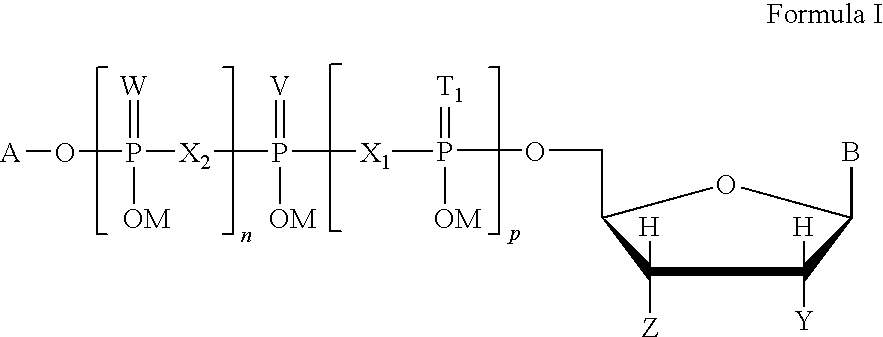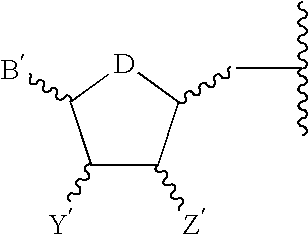P2Y6 receptor agonists for treating lung diseases
a technology of p2y6 receptor and agonist, which is applied in the direction of biocide, drug composition, animal husbandry, etc., can solve the problems of increasing morbidity and mortality, and achieve the effect of facilitating or enhancing the clearance facilitating the hydration of lung mucus secretions
- Summary
- Abstract
- Description
- Claims
- Application Information
AI Technical Summary
Benefits of technology
Problems solved by technology
Method used
Image
Examples
example 1
Preparation of P1-(2′,3′-benzylacetal uridine 5′-) P3-(uridine 5′-) triphosphate, Ammonium Salt
Uridine 5′-diphosphate, tributylammonium salt (UDP.NBu3)
[0119]Uridine 5′-diphosphate, disodium salt (UDP.2Na) was converted to the free acid by stirring with Dowex 50 H+ or equivalent (5 g resin / g UDP.2Na) in water for 10 minutes. The resin was filtered and the filtrate was combined with tributylamine (1.5 eq.). The mixture was stirred vigorously for 15 minutes, such that the pH of the aqueous layer remained above 8. The solution was evaporated at <35° C., and the residue co-evaporated with dry N,N-dimethylformamide (3×), at <40° C. The residue was lyophilized overnight to a dry glassy foam.
Uridine 5′-monophosphate, tributylammonium salt (UMP.NBu3)
[0120]Uridine 5′- monophosphate, free acid (UMP) was converted to the mono-tributylammonium salt by treatment with tributylamine (1.5 eq.) in water. Following solvent removal and co-evaporation with dry N,N-dimethylformamide, the product was lyop...
example 2
Selectivity of UDP, UP3U and Mono-benzylacetal UP3U
[0124]Human astrocytoma (1321N1) cells expressing P2Y1, P2Y2, P2Y4, and P2Y6 were grown to confluency in 96-well plates. Cells were loaded with a solution of Fluo-3 AM (2.5 μM final concentration) in an assay buffer consisting of 10 mM KCl, 118 mM NaCl, 2.5 mM CaCl2, 1 mM MgCl2, 20 mM HEPES, 10 mM glucose, pH 7.4. After a 60-minute incubation with Fluo-3 AM at 25° C., cells were washed and stimulated with serially diluted concentrations of compounds uridine 5′-diphosphate (UDP), P1, P3-(diuridine 5′-) triphosphate (UP3U) or P1-(2′,3′-benzylacetal uridine 5′-) P3-(uridine 5′-) triphosphate (mono-benzylacetal UP3U). Intracellular calcium levels were monitored in each well simultaneously by measuring the changes in fluorescence intensity using the FLIPR (Molecular Devices Corp., Sunnyvale, Calif.). The results of this assay are presented in Table 1. Values for compounds UDP, UP3U, and mono-benzylacetal UP3U in Table 1 are presented as ...
example 3
Chloride Secretion in Human Nasal Airway Cells
[0126]Induction of chloride secretion in vivo facilitates hydration of thickened airway mucus secretions in diseases where patients will benefit from mobilization and clearance of such secretions. Activation of an apical non-CFTR chloride channel induce efflux of chloride ions and water that help rehydrate the lung secretions (Boucher, U.S. Pat. No. 5,292,498 and Boucher, U.S. Pat. No. 5,635,160 and references therein).
[0127]Airway epithelial cells are dispersed and isolated from freshly excised human nasal surgical specimens (Yankaskas, et al., Am Rev Resp Dis 132, 1281-1287 (1985)). Confluent monolayers are cultured on permeable collagen matrix supports in F-12 hormone-supplemented medium (Wu, et al., Am Rev Resp Dis 132, 311-320 (1985)). Cells are incubated at 37° C. and grown to confluence. Development of transepithelial resistance is monitored to determine the formation of tight junctions between cells. After formation of tight junc...
PUM
| Property | Measurement | Unit |
|---|---|---|
| size | aaaaa | aaaaa |
| thick | aaaaa | aaaaa |
| size | aaaaa | aaaaa |
Abstract
Description
Claims
Application Information
 Login to View More
Login to View More - R&D
- Intellectual Property
- Life Sciences
- Materials
- Tech Scout
- Unparalleled Data Quality
- Higher Quality Content
- 60% Fewer Hallucinations
Browse by: Latest US Patents, China's latest patents, Technical Efficacy Thesaurus, Application Domain, Technology Topic, Popular Technical Reports.
© 2025 PatSnap. All rights reserved.Legal|Privacy policy|Modern Slavery Act Transparency Statement|Sitemap|About US| Contact US: help@patsnap.com



